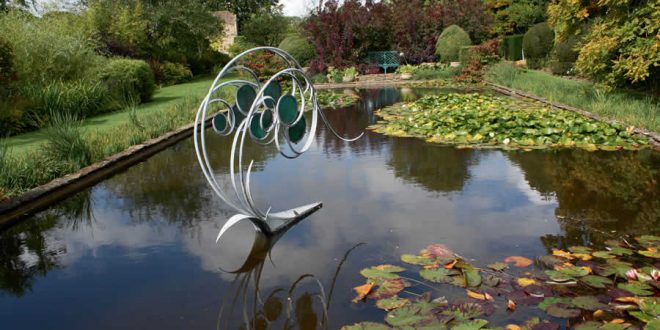Natural Talent
Jenny Pickford is a skilled blacksmith and artist. A former pupil at Lord Williams School in Thame she creates stunning, larger than life sculptures. See her work this Autumn at Waterperry Gardens.
There aren’t many female blacksmiths, and there aren’t many metalworkers of any gender who regularly produce work that stands three or four metres high.
But then Jenny Pickford is an unusual artist. Originally studying in fine art, she switched to learning blacksmithing at Hereford College because she wanted to work on a larger scale. Today she’s recognised internationally as one of the country’s leading artist-blacksmiths, with a signature style that combines forged steel with blown glass to make fluid, organic shapes of recognisable plants with leaves, stalks and flowers … and they’re spectacularly oversized.
“I love the technical challenges of creating a huge work that will be stable when it’s installed and maybe shiver a little in the breeze. I like to stop people in their tracks.”
Jenny’s sculptures are intended to grab the attention, to make you really see and feel the swirls and swoops of nature. The sheer scale draws attention to the delicacy and sensitivity of the sinuous shapes – but you also know the strength of the piece, because it’s made of metal and glass.
Of course she takes her inspiration from the natural environment: “Look at the forms you find in nature; they’re delicate, yet strong. They’re beautiful, yet functional. My work is all about those contrasts.”
“Someone once asked me why I didn’t just do life-sized flowers. Well, flowers are that size. An agapanthus wouldn’t gain anything from me doing a metal copy of it. But an agapanthus that’s taller than you are – now that really says something.”
Her working style is largely intuitive. Where some contemporary metalworkers will spend hours with design software and computerised cutting tools, Jenny is more likely to start in the workshop. “I make it up as I go along,” she laughs.
It’s not as simple as that, of course; she will spend time developing the idea in her head, and she understands so much about the possibilities of the materials she uses that she doesn’t need a precision-tooled design. When working on public art and private commissions Jenny provides detailed drawings of the design, but many of her sculptures are made just to satisfy her creative whims. For these, a chalk outline on the workshop floor is likely to be as much preliminary detail as a sculpture receives before she starts work.
Jenny has shown her work regularly at the Chelsea Flower Show and other RHS events like the Tatton Park, Malvern and Hampton Court shows.
She doesn’t usually show her work in large groups; they simply need too much space for most exhibition venues, and besides she’s usually busy with individual commissions. Just before this year’s Wimbledon tennis championship she installed a 3m high dandelion-inspired piece outside the players’ entrance; not long ago she was in China, supervising the installation of a 4m hibiscus in Chengdu.
Some years ago she was awarded a Queen Elizabeth Scholarship Trust bursary to study at the well-known Pilchuck Glass School in Washington, USA, and she’s been a supporter of QEST ever since – regularly donating work to QEST’s fundraising auctions, for instance. An allium flower sculpture raised around £10,000 at a Christie’s sale in 2015; The QEST connection has meant a recent invitation to Prince Charles’ 70th birthday garden party at Buckingham Palace.
But Waterperry Gardens provides the ideal backdrop for a solo show, and this Autumn Jenny will be showing more than two dozen recent sculptures there under the name SuperNature III (SuperNature I was in 2015, at the National Trust’s Courts Garden in Holt; SuperNature II was Jenny’s first solo show, at Waterperry in 2017).
“I love Waterperry Gardens, the mix of formality and areas that are still uncultivated woodland. Maybe because I can see so many suitable locations for my work – some pieces suit the formal areas, others relate so well to the wilder, more open settings.”
Jenny grew up on a farm four miles from Waterperry and still has family in the area; she feels a strong connection to the Oxfordshire countryside where her artistic imagination was forged.
“And this is a place I can particularly relate to. When it was run as Waterperry Horticultural School in the early 1930s it was a pioneering project, a residential horticultural college specifically for women.
“Professional women gardeners weren’t common, and I like to think I’m in the same tradition – there aren’t too many women blacksmiths!
The warm feelings must be mutual; in 2016 Jenny was commissioned to produce a decorative gate for Waterperry Gardens. She produced a design inspired by the herbaceous borders (and capable of keeping out the rabbits too).
Today she lives and works in rural Herefordshire – she studied blacksmithing at Hereford College – but her clients come from all over the world. “The beauty of nature is an international language, isn’t it?” she says. “I’m just glad I’m picking up enough of the vocabulary.”
You can read more articles like this one in the latest edition of Thame Out.
 Thame Out The complimentary magazine for the Thame area
Thame Out The complimentary magazine for the Thame area


